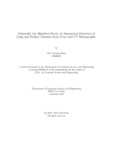| dc.description.abstract | Radiology imaging, such as magnetic resonance imaging (MRI), computed tomography
(CT-scan), X-ray imaging (X-ray), and ultrasound imaging (US), is used to
diagnose a variety of disorders, including brain disease, whole-body difficulties, kidney
disease, COVID 19, dental status and many more. Out of those diseases, one
of the lung diseases, the coronavirus epidemic has spread to virtually every country
on the globe, inflicting enormous health, financial, and emotional devastation,
as well as the collapse of healthcare systems in some countries. Any automated
COVID detection system that allows for fast detection of the COVID-19 infection
might be highly beneficial to the healthcare system and people around the world.
Molecular or antigen testing along with radiology X-ray imaging and CT scan radiographs
are now utilized in clinics to diagnose COVID-19. Nonetheless, due to
a spike in coronavirus and the overwhelming workload of doctors, developing an
AI-based auto-COVID detection system with high accuracy has become imperative.
Given the enigmatic nature of COVID-19 visual markers, lung opacity, and viral
pneumonia, diagnosis can be challenging as the three diseases look quite similar in
nature on x-ray images. Past studies related to lung disease auto detection were
mostly performed on small datasets and the majority of the studies did not reveal
the blackbox of models. Furthermore, despite the fact that there are a large number
of infected people around the world, the amount of COVID data sets needed
to build an AI system is limited and dispersed. Moreover, renal failure, a public
health concern, and the scarcity of nephrologists around the globe have necessitated
the development of an AI-based system to auto-diagnose kidney diseases. For this
thesis, we chose two imaging modalities to study: x-ray and CT scan images. We
automated and assessed our established models for lung illnesses (COVID 19, lung
opacity, and viral pneumonia). Furthermore, utilizing CT images, we constructed
models to automate kidney disease (kidney tumor, cyst, and stone). This research
utilized artificial intelligence (AI) to deliver high-accuracy automated COVID-19
detection from normal chest X-ray images. Further, this study was extended to differentiate
COVID-19 from normal, lung opacity, and viral pneumonia x-ray pictures.
We constructed six models and trained them with x-ray images. Out of those six
models, three can be used to categorize normal and COVID diseases (i.e., binary
class classification). The other three can be used to categorize normal, COVID-
19, lung opacity, and viral pneumonia images (i.e., four-class classification). All
models were trained and validated using the transfer learning approach and then
tested with unseen x-ray pictures. Each of the binary class models was trained with
different input picture resolutions, and it was found that greater input image resolution
training contributed to the model’s better performance and accuracy. With
the employed two-class classification model, the best accuracy, precision, and recall
are found to be 97.5%, 99.5% and 99.5%, respectively. The high accuracy of this
test can significantly assist in reducing global suffering from COVID-19. Moreover,
three models’ decisions are verified and compared by visualizing all internal layers,
including the final layer’s heatmap utilizing GradCam. The best accuracy found for
the multiclass model is 93% while testing the model with unseen data. Each of the
three multiclass models is explained using explainable AI to uncover the blackbox
of the models.In this letter, we also presented a chest CT scan data set for COVID
and healthy patients considering a varying range of severity of COVID, which we published on kaggle and that can assist other researchers to contribute to healthcare
AI. We also developed three deep learning approaches for detecting COVID
quickly and cheaply from chest CT radiographs. Our three transfer learning-based
approaches, Inception v3, Resnet 50, and VGG16, achieve accuracy of 99.8%, 91.3%,
and 99.3%, respectively, on unseen data. We delve deeper into the black boxes of
those models to demonstrate how our model comes to a certain conclusion, and we
found that, despite the low accuracy of the model based on VGG16, it detects the
COVID spot in images well, which we believe may further assist doctors in visualizing
which regions are affected.This research also deals with the three major renal
diseases categories: kidney stones, cysts, and tumors, and gathered and annotated
a total of 12,446 CT whole abdomen and urogram images in order to construct an
AI-based kidney diseases diagnostic system and contribute to the AI community’s
research scope. The collected images were exposed to exploratory data analysis,
which revealed that the images from all of the classes had the same type of mean
color distribution. Furthermore, six machine learning models were built, three of
which are based on the state-of-the-art variants of the Vision transformers EANet,
CCT, and Swin transformers, while the other three are based on well-known deep
learning models Resnet, VGG16, and Inception v3, which were adjusted in the last
layers. While the VGG16 and CCT models performed admirably, the swin transformer
outperformed all of them in terms of accuracy, with an accuracy of 99.30
percent. The F1 score and precision and recall comparison reveal that the Swin
transformer outperforms all other models and that it is the quickest to train. The
study also revealed the blackbox of the VGG16, Resnet50, and Inception models,
demonstrating that VGG16 is superior than Resnet50 and Inceptionv3 in terms of
monitoring the necessary anatomy abnormalities. We believe that the superior accuracy
of our Swin transformer-based model and the VGG16-based model can both
be useful in diagnosing kidney tumors, cysts, and stones. | en_US |

